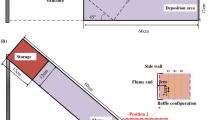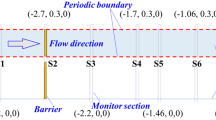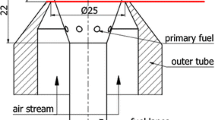Abstract
Baffle structure, a promising countermeasure in reducing the destruction power of rapid granular flows, needs more investigation especially with focus on the physically based design strategy. To contribute to this point, we conduct a series of numerical modeling tests to investigate the impact dynamics of monodisperse and bidisperse granular flows against the baffle array, based on which a jet-based model for estimation of the peak impact force and run-up height is proposed for baffle design. The results show that the energy loss due to interparticle interaction increases with the Froude number; the hard contact of larger particles and the arching effect of debris–baffle interaction are important to the impact dynamics on baffle structure; the baffle design could ignore the static force component, at least for rapid granular flow with the smaller ratio of the baffle slit size to the particle size; and for the bidisperse granular flow impact, the effect of larger particles is only dominant when the percentage of larger particles is large because fine debris could provide a cushioning effect. A jet-based model considering conservation equations for momentum and energy is then proposed for baffle design with the introduction of jamming-related momentum and energy discharge process. The model is verified using numerical data in terms of the run-up height and impact force. On the basis of the proposed model, baffle design is further discussed considering flow material inhomogeneity and unsteady flow dynamics.
















Similar content being viewed by others
References
Ahmadipur A, Qiu T, Sheikh B (2019) Investigation of basal friction effects on impact force from a granular sliding mass to a rigid obstruction. Landslides 16(6):1089–1105. https://doi.org/10.1007/s10346-019-01156-0
Albaba A, Lambert S, Faug T (2018) Dry granular avalanche impact force on a rigid wall: analytic shock solution versus discrete element simulations. Phys Rev E 97(5–1):052903. https://doi.org/10.1103/PhysRevE.97.052903
Armanini A, Rossi G, Larcher M (2019) Dynamic impact of a water and sediments surge against a rigid wall. J Hydraul Res 58(2):314–325. https://doi.org/10.1080/00221686.2019.1579113
Bi YZ, Du YJ, He SM, Sun XP, Wang DP, Li XP, Liang H, Wu Y (2018) Numerical analysis of effect of baffle configuration on impact force exerted from rock avalanches. Landslides 15(5):1029–1043. https://doi.org/10.1007/s10346-018-0979-z
Cagnoli B (2021) Stress level effect on mobility of dry granular flows of angular rock fragments. Landslides. https://doi.org/10.1007/s10346-021-01687-5
Choi CE, Au-Yeung SCH, Ng CWW, Song D (2015) Flume investigation of landslide granular debris and water runup mechanisms. Géotechnique Letters 5(1):28–32. https://doi.org/10.1680/geolett.14.00080
Cui Y, Choi CE, Liu LHD, Ng CWW (2018) Effects of particle size of mono-disperse granular flows impacting a rigid barrier. Nat Hazards 91(3):1179–1201. https://doi.org/10.1007/s11069-018-3185-3
Dowling CA, Santi PM (2014) Debris flows and their toll on human life: a global analysis of debris-flow fatalities from 1950 to 2011. Nat Hazards 71(1):203–227. https://doi.org/10.1007/s11069-013-0907-4
Faug T (2021) Impact force of granular flows on walls normal to the bottom: slow versus fast impact dynamics. Can Geotech J 58(1):114–124. https://doi.org/10.1139/cgj-2019-0399
Goodwin GR, Choi CE (2021) Translational inertial effects and scaling considerations for coarse granular flows impacting landslide-resisting barriers. J Geotech Geoenviron Eng 147(12). https://doi.org/10.1061/(asce)gt.1943-5606.0002661
Goodwin GR, Choi CE, Yune C-Y (2020) Towards rational use of baffle arrays on sloped and horizontal terrain for filtering boulders. Can Geotech J. https://doi.org/10.1139/cgj-2020-0363
Goodwin GR, Choi CE, Yune CY (2021) Towards rational use of baffle arrays on sloped and horizontal terrain for filtering boulders. Can Geotech J 58(10):1571–1589. https://doi.org/10.1139/cgj-2020-0363
Ho KKS, Koo RCH, Kwan JSH (2021) Mitigation of debris flows—research and practice in Hong Kong. J Environ Eng Geo 27(2):231–243. https://doi.org/10.2113/EEG-D-20-00009 .
Huang Y, Zhang B (2020) Challenges and perspectives in designing engineering structures against debris-flow disaster. Eur J Environ Civ Eng. https://doi.org/10.1080/19648189.2020.1854126
Huang Y, Zhang B, Zhu C (2020) Computational assessment of baffle performance against rapid granular flows. Landslides 18(1):485–501. https://doi.org/10.1007/s10346-020-01511-6
Iverson RM, George DL, Logan M (2016) Debris flow runup on vertical barriers and adverse slopes. J Geophys Res Earth Surf 121(12):2333–2357. https://doi.org/10.1002/2016jf003933
Jianbo F, Yuxin J, Xiaohui S, Xi C (2020) Experimental investigation on granular flow past baffle piles and numerical simulation using a μ(I)-rheology-based approach. Powder Technol 359:36–46. https://doi.org/10.1016/j.powtec.2019.09.069
Jiang Y-J, Zhao Y, Towhata I, Liu D-X (2015) Influence of particle characteristics on impact event of dry granular flow. Powder Technol 270:53–67. https://doi.org/10.1016/j.powtec.2014.10.005
Jiang YJ, Towhata I (2013) Experimental study of dry granular flow and impact behavior against a rigid retaining wall. Rock Mech Rock Eng 46(4):713–729. https://doi.org/10.1007/s00603-012-0293-3
Koo RCH, Kwan JSH, Ng CWW, Lam C, Choi CE, Song D, Pun WK (2016) Velocity attenuation of debris flows and a new momentum-based load model for rigid barriers. Landslides 14(2):617–629. https://doi.org/10.1007/s10346-016-0715-5
Kwan J (2012) Supplementary technical guidance on design of rigid debris-resisting barriers. In: HK (ed) Geotech Eng Office, p 88
Li X, Zhao J, Soga K (2020) A new physically based impact model for debris flow. Géotechnique. https://doi.org/10.1680/jgeot.18.P.365
Ng CWW, Choi CE, Goodwin GR (2019) Froude characterization for unsteady single-surge dry granular flows: impact pressure and runup height. Can Geotech J 56(12):1968–1978. https://doi.org/10.1139/cgj-2018-0529
Ng CWW, Choi CE, Song D, Kwan JHS, Koo RCH, Shiu HYK, Ho KKS (2014) Physical modeling of baffles influence on landslide debris mobility. Landslides 12(1):1–18. https://doi.org/10.1007/s10346-014-0476-y
Ng CWW, Song D, Choi CE, Liu LHD, Kwan JSH, Koo RCH, Pun WK (2016) Impact mechanisms of granular and viscous flows on rigid and flexible barriers. Can Geotech J 54(2):188–206. https://doi.org/10.1139/cgj-2016-0128
Pudasaini SP, Hutter K, Hsiau S-S, Tai S-C, Wang Y, Katzenbach R (2007) Rapid flow of dry granular materials down inclined chutes impinging on rigid walls. Phys Fluids 19(5):053302. https://doi.org/10.1063/1.2726885
Rossi G, Armanini A (2019) Impact force of a surge of water and sediments mixtures against slit check dams. Sci Total Environ 683:351–359. https://doi.org/10.1016/j.scitotenv.2019.05.124
Shen WG, Zhao T, Zhao JD, Dai F, Zhou GGD (2018) Quantifying the impact of dry debris flow against a rigid barrier by DEM analyses. Eng Geol 241:86–96. https://doi.org/10.1016/j.enggeo.2018.05.011
Song D, Chen X, Zhou GGD, Lu X, Cheng G, Chen Q (2021) Impact dynamics of debris flow against rigid obstacle in laboratory experiments. Eng Geol. https://doi.org/10.1016/j.enggeo.2021.106211
Song D, Choi CE, Zhou GGD, Kwan JSH, Sze HY (2018) Impulse load characteristics of bouldery debris flow impact. Géotechnique Letters 8(2):111–117. https://doi.org/10.1680/jgele.17.00159
Tan DY, Yin JH, Feng WQ, Zhu ZH, Qin JQ, Chen WB (2019) New simple method for calculating impact force on flexible barrier considering partial muddy debris flow passing through. J Geotech Geoenviron Eng 145(9). https://doi.org/10.1061/(asce)gt.1943-5606.0002133
Wang DP, Li QZ, Bi YZ, He SM (2020) Effects of new baffles system under the impact of rock avalanches. Eng Geol 264:105261. https://doi.org/10.1016/j.enggeo.2019.105261
Wang GL (2013) Lessons learned from protective measures associated with the 2010 Zhouqu debris flow disaster in China. Nat Hazards 69(3):1835–1847. https://doi.org/10.1007/s11069-013-0772-1
Yang E, Bui HH, Nguyen GD, Choi CE, Ng CWW, De Sterck H, Bouazza A (2021) Numerical investigation of the mechanism of granular flow impact on rigid control structures. Acta Geotech. https://doi.org/10.1007/s11440-021-01162-4
Zhang B, Huang Y (2022a) Effect of unsteady flow dynamics on the impact of monodisperse and bidisperse granular flow. Bull Eng Geol Environ 81(2). https://doi.org/10.1007/s10064-022-02573-7
Zhang B, Huang Y (2022b) Impact behavior of superspeed granular flow: insights from centrifuge modeling and DEM simulation. Eng Geol 299:106569. https://doi.org/10.1016/j.enggeo.2022.106569
Zhang B, Huang Y (2022c) Impact behavior of dry granular flow against baffle structure: coupled effect of Froude and particle characteristics. Géotechnique. (Under review)
Zhang B, Huang Y, Liu J (2021) Micro-mechanism and efficiency of baffle structure in deceleration of granular flows. Acta Geotech. https://doi.org/10.1007/s11440-021-01290-x
Zhang B, Huang Y, Lu P, Li C (2020) Numerical investigation of multiple-impact behavior of granular flow on a rigid barrier. Water 12(11). https://doi.org/10.3390/w12113228
Zhou GGD, Du JH, Song DR, Choi CE, Hu HS, Jiang, C.h. (2019) Numerical study of granular debris flow run-up against slit dams by discrete element method. Landslides 17(3):585–595. https://doi.org/10.1007/s10346-019-01287-4
Funding
This work was supported by the National Natural Science Foundation of China (Grant No. 41831291).
Author information
Authors and Affiliations
Corresponding author
Ethics declarations
Competing interests
The authors declare no competing interests.
Appendix. DEM contact model
Appendix. DEM contact model
The DEM simulations in this paper are conducted using EDEM software, which offers an efficient contact model referred to as a Hertz–Mindlin (no-slip) contact model combined with an anti-rolling model to compensate for the simplification of the real particle shape in DEM simulation:
Here, the subscripts n and t respectively indicate the normal and tangential directions. And the definitions of variables are presented in Nomenclature.
Nomenclature | |
|---|---|
DEM contact model | \({F}_{n}^{c}\), \({F}_{t}^{c}\): normal and tangential contact force; K: elastic stiffness constant; D: damping coefficient; \(\lambda\): overlap; \({v}^{rel}:\) relative velocity; \({\mu }_{s}:\)coefficient of Coulomb friction; \({\mu }_{r}\): rolling friction coefficient; \({d}_{i}\): distance between the contact point and center of mass; \({\widehat{\omega }}_{i}\): unit angular velocity. |
Baffle layout | \({L}_{B}\): baffle array spacing; \({S}_{B}\): slit spacing; \({W}_{F}\): flume width; \({h}_{B}\): baffle height; \({W}_{B}\): baffle width; B: opening ratio. |
Flow properties | \({h}_{f}\): flow depth; \({u}_{f}\): flow velocity; \(\delta\): particle diameter; \({u}_{f}\): flow velocity; \({\phi }_{f}\): solid volume fraction; \({\rho }_{s}\): particle density: \({N}_{Fr}\): Froude number; \({E}_{k}\): kinetic energy: \({E}_{p}\): potential energy; \({E}_{d}\): dissipated energy; \({E}_{r}\): energy loss due to particle removal; \({E}_{s}\): elastic strain energy. |
Design Parameters | \({F}_{n}\): total impact force; \({F}_{n}^{s}\): static force component; \({F}_{n}^{d}\): dynamic force component; \({\Psi }_{m}\): momentum reduction coefficient; \({\Psi }_{u}\): velocity reduction coefficient; \({h}_{r}\): run-up height; \({\Psi }_{e}\): energy reduction coefficient; \({\kappa }_{f}\): longitudinal pressure coefficient; \({\gamma }_{r}\): empirical coefficient for compensation of the overestimation of run-up height; \({\alpha }_{0}\): force correction coefficient. |
Rights and permissions
About this article
Cite this article
Zhang, B., Huang, Y. Numerical and analytical analyses of the impact of monodisperse and bidisperse granular flows on a baffle structure. Landslides 19, 2629–2651 (2022). https://doi.org/10.1007/s10346-022-01927-2
Received:
Accepted:
Published:
Issue Date:
DOI: https://doi.org/10.1007/s10346-022-01927-2




